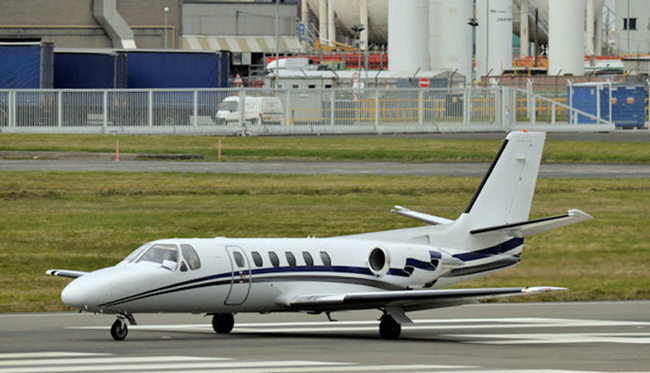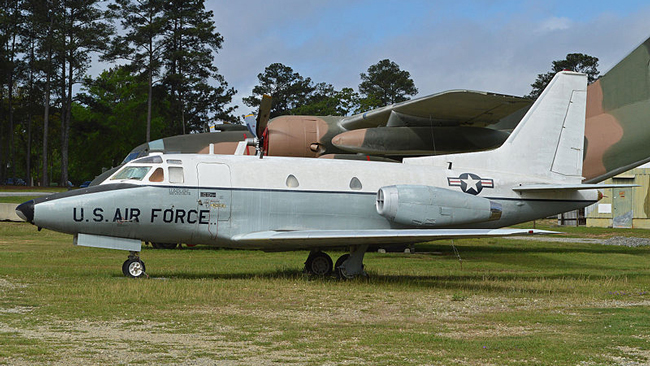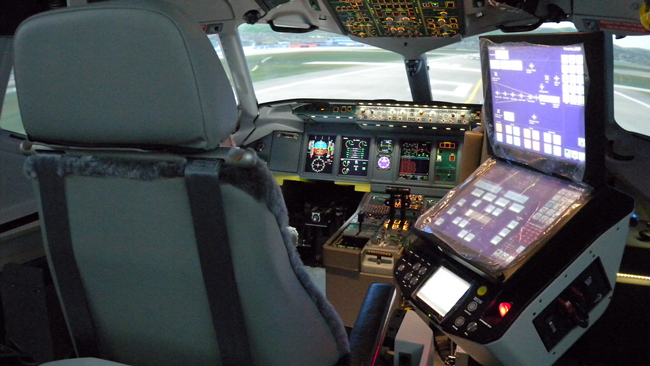Did you know that 7 of the Top 8 Vital Upset Prevention and Recovery Training (UPRT) Success Elements are dependent on optimized training platform integration? In fact, those essential elements of success have little to do with the specific type, class, or size of the airplane you operate.
As a jet pilot, you may have wondered about claims such as:
“Business Jet Pilots Must Do Upset Training in Business Jets”
or
“Why train in a Ferrari when you drive a Mack truck?”

The Mack truck in this inappropriate metaphor represents your business jet or transport category airliner. That byline might be valid if you weren’t already an expert at operating your aircraft (the Mack truck in the metaphor), or if the critical training you needed to save your life had anything of comparative significance to do with a truck’s handling qualities. In fact, the most effective training platforms for UPRT depend entirely upon the critical ‘Success Elements’ that must be accomplished to enhance your relevant skill sets. Effective upset training is dependent on the comparative strengths and weaknesses of the purpose-built training platforms used to accomplish those ‘Success Elements’ (see ‘Top 8 Vital UPRT Success Elements’ in the bullet list below).
Executive Summary of Take-aways
The UPRT platform considerations below first and foremost take into account safety and critical skill set development, as well as optimal upset training value including effectiveness, efficiency, and cost. Each consideration will be further explained below.
- Business Jets Are Marginal: Compared to other purpose-built resources, business jets are the least effective on-aircraft upset training platform.
- ICAO Says No: ICAO specifically states that transport category airplanes, and airplanes requiring two or more crew members should not be used for on-aircraft UPRT.
- Maximized UPRT is Well Defined: Integrated UPRT for jet pilots should include all of the following: eLearning, instructor-led ground instruction, on-aircraft upset training in aerobatic-capable piston and jet airplanes, and advanced multi-engine, simulators incorporating advanced avionics.
- Top 8 Vital UPRT Success Elements (Relative Weight [RW] in Training Value)
(Expanded Information in Table 1)- #1 Human Factors (10/10 Relative Weight (RW)): (Startle & Stress Response)
Best Platform: Aerobatic Piston - #2 All-Attitude Environment Immersion (10/10 RW)
Best: Aerobatic Piston and Jet - #3 Strategy Application Resilience in Crisis (9/10 RW):
Best: Aerobatic Piston and Jet - #4 G-Awareness (8/10 RW):
Best: Aerobatic Piston and Jet - #5 Repetition to Proficiency (Practice) in Wide Diversity of Upset Conditions (8/10 RW)
Best: Aerobatic Piston and Jet - #6 Crew Resource Management – CRM (7/10 RW)
Best: Simulator - #7 Very Low Altitude and All-Weather Upsets (6/10 RW)
Best: Simulator - #8 Representative Control Feel and Response (5/10 RW)
Best: Simulator
- #1 Human Factors (10/10 Relative Weight (RW)): (Startle & Stress Response)
At APS, we always use the best platform to achieve the learning objectives of each of the Top 8 Vital UPRT Success Elements. Even so, this clear advantage of platform-selection is only part of why APS is the top UPRT provider globally. Call USA 1-480-279-1881 to speak to our team to learn more.
Training Platform Terminology
Due to the unique characteristics of the variations of airplanes used in UPRT, this discussion benefits from defining key terminology regarding training platforms:
Business Jet or Non-Aerobatic Jet
Business jet airplanes, including transport category, commuter, and any single or mulit-engine jet airplane not originally certified by the manufacturer for aerobatic maneuvering or intentional spins, are not generally certificated or safe to operate at greater than 30 degrees of pitch and/or 60 degrees of bank. This also includes airplanes falling into this category where the operator has received a Letter of Deviation Authority (LODA) or similar to permit the operation of the airplane beyond its original design specifications.


Aerobatic Piston
Now let’s look at commercially certified piston aerobatic airplanes. In this discussion, we are specifically referring to higher performance aerobatic airplanes that have roll rates greater than 200 degrees per second and pitch rates greater than 20 degrees per second. Lower performing piston aerobatic airplanes are markedly less effective at addressing the human factors listed as the #1 Vital UPRT Success Element in Table 1. For low performance aerobatic piston airplanes, their training value is more aptly aligned with the ‘Aerobatic Jet’ category, without the value of jet engine handling benefits.

Aerobatic Jet
This category includes turbofan, or turbojet aerobatic airplanes with roll rates in excess of 120 degrees per second and pitch rates greater than 10 degrees per second. This category includes commercially certified aerobatic jet airplanes, if and when they come on the market, and former military airplanes originally designed by the manufacturer for intentional spins, and aerobatic maneuvering through 360 degrees of pitch and roll. Military airplanes in this category require a Letter of Deviation Authority (LODA) with specific approval to conduct UPRT from the regulating authority.

Simulator
This platform type includes class-specific advanced multi-engine simulator with advanced avionics, side by side seating, and a representative and validated aeromodel, approved for the maneuvers being conducted. All maneuvers conducted should be contained within the approved operating envelope. Extended envelope simulators have a marginally increased training value of approximately 2 to 3% over non-extended envelopes.

A Measure of Value in Business Jet Upset Training
To be fair, there is a measure of value to Business Jet Upset Training (see Table 1 below), especially if its used after the core UPRT skills, knowledge, and disciplines are firmly established through a robust and integrated UPRT program that places priority on the Top 8 Vital UPRT Success Elements. However, on its own or as part of a limited program of just two or three flights, it’s not the best initial UPRT choice from the standpoints of both training effectiveness and training value. The unconditional objective of life-saving UPRT is to create resilient pilots who can quickly and correctly access the right skills at the right time in a life-threatening crisis. There are vastly better and, surprisingly, more economical ways to ingrain the skills pilots really need.
“How the controls of the airplane feel and their responsiveness have little to do with the core skills and disciplines necessary to survive a time-critical, life-threatening airplane upset event.”
What Does the Industry Say About Business Jet Upset Training?
Other than UPRT providers that happen to have a business jet in their inventory and want to put it to work, the industry says surprisingly little about the role of business jets in UPRT. But it’s not because it was missed. Most experts, including the 80 industry-wide experts that worked on solving the Loss of Control In-flight (LOC-I) threat for five years including the FAA, NASA, Boeing, Airbus, Bombardier, Embraer, ATR and a total of 40 organizations, came to the same conclusion. As they emphasized in the International Civil Aviation Organization (ICAO) document they produced, ICAO Doc 10011 – Manual on Aeroplane Upset Prevention and Recovery Training:
“On-aeroplane UPRT is not intended to be delivered while operating transport category aeroplanes or aeroplanes requiring two or more crew members; for those operations, UPRT should not be permitted to be conducted outside the confines of a suitable FSTD.”
These aircraft are included in Table 1 as defined by the Non-Aerobatic Jet platform.
The contributors in the collaborative efforts that led to that foundational Manual on Aeroplane Upset Prevention and Recovery Training (document 10011) understood the Top 8 Vital UPRT Success Elements that must be addressed during initial and recurrent training. The Representative Control Feel and Response (See Table 1) of the training platform in relation to the trainee’s airplane matters; however, it’s far from being the most important Vital UPRT Success Element of an effective program that’s targeted on overcoming Loss of Control In-flight (LOC-I) to saves lives. In fact, it’s considered the least critical of the top eight (8) elements illustrated in Table 1 below. With respect, it does merit attention as it did make into the Top 8.
UPRT is Not Aerobatics
Despite an aerobatic airplane being the best platform for many of the Vital UPRT Training Elements, it’s important to emphasize that UPRT is NOT aerobatic training. Aerobatics are precision, type-specific, planned maneuvering, where as UPRT is non-precision, non-type-specific, unplanned maneuvering. In many ways, they have the exact opposite targeted learning objectives of each other, although they both contribute to manual handling proficiency.
Vital UPRT Training Elements – Your Decision Matrix
Broadly stated, an effective UPRT program that embeds lasting and accessible skill sets in a startling, airplane upset event, is based on the following items with the associated weight established in accordance with the Every Pilot In Control Solution StandardTM:
(Note: due to size, the following chart may be difficult to read on mobile devices. You can download the PDF version here.)
Vital UPRT Success Elements¹ | Weight† | Best Platform | Priority†† |
#1 Human Factors² | 10 | Best: Aerobatic Piston | 1 |
#2 All-Attitude Environment Immersion | 10 | Best: Aerobatic Piston and Jet | 1 |
#3 Strategy Application Resilience in Crisis | 10 | Best: Aerobatic Piston and Jet | 1 |
#4 G-Awareness⁵ | 8 | Best: Aerobatic Piston and Jet | 2 |
#5 Repetition to Proficiency ⁶ | 8 | Best: Aerobatic Piston and Jet | 2 |
#6 Very Low Altitude and All-Weather Upsets⁷ | 7 | Best: Simulator | 3 |
#7 Crew Resource Management (CRM)⁸ | 6 | Best: Simulator (trainees in both seats) | 3 |
#8 Representative Control Feel and Response⁹ | 5 | Best: Simulator and Some Non-Aerobatic Pistons & Jets | 3 |
† Relative Weight: 10 represents the maximum importance. Ie. 10 is twice as important as 5. | |||
At APS, we use the best training platforms available to address the Vital training elements in the most effective manner possible. We don’t create marketing claims to rationalize the use of platforms to support another business that’s not UPRT. Here are a few facts about APS that demonstrate our unwavering commitment to aviation safety:
- APS does not offer initial UPRT programs with less than 4 flights and 2.5 days. Its been conclusively demonstrated skills don’t last and resilience is compromised in the vast majority of professional pilots without that degree of UPRT,
- APS addresses the Vital UPRT Success Elements in the appropriate order and with the necessary intensity relative to their presence in accident statistics,
- APS integrates eLearning, live instructor-led ground instruction, aerobatic piston and jet aircraft, along with advanced simulation,
- APS is the trusted UPRT provider to two major legacy US air carriers, insurance agencies, militaries, and over 100 flight departments worldwide.
- APS does not use business jets because they are marginally effective compared to readily available, highly effective, and more economical UPRT platforms.
- APS has published the Every Pilot In Control Solution StandardTM for all UPRT providers, organizations, and pilots committed to solving LOC-I, aviation’s #1 fatal threat to air safety.
- APS is committed to helping all pilots and training organizations overcome LOC-I, not just our customers.
What Are the Advantages of Business Jet Upset Training?
There are a few, certainly, as long as it’s part of a comprehensive UPRT program that addresses the main training requirements. Maneuvering a business jet marginally beyond your everyday, normal flight operations proportionally increases your awareness and experience in more aggressive operations. The presence of accurate motion cueing and buffeting (although the practical value of slow and high-speed buffeting experience is highly type-specific) has awareness value. However, all of these same elements are available to the trainee during the more robust and comprehensive use of aerobatic piston and jet airplanes. Furthermore, the value of the simulator in UPRT substantially outweighs the non-aerobatic-jet’s training value in that the simulator allows for true CRM UPRT (trainees in both required crew members seats), very low altitude upset events, and night/all-weather airplane upsets.
At APS, all we do is UPRT. We Help Pilots Bring Everyone Home Safely.
We are 100% committed to our brand promise: Every Pilot Training – In Control – All The Time.
About the Author

Paul ‘BJ’ Ransbury
President and CEO
Aviation Performance Solutions (APS)
Paul BJ Ransbury, a former military instructor and airline pilot, is the CEO of Aviation Performance Solutions, well known as APS. APS has specialized in comprehensive Upset Prevention and Recovery Training, UPRT, for professional pilots for three decades. As the ‘go-to’ UPRT provider for major US air carriers, insurance companies, government agencies, and corporate flight departments worldwide, APS’s proprietary Loss of Control In-flight solutions are delivered to tens of thousands of pilots annually.
More on Paul BJ Ransbury’s Background and Experience: apstraining.com/ransbury
Related Articles:
Endnotes
1. The prioritization, weight, platform assessments, and order of the Top 7 Vital UPRT Success Elements in this table are based on the direct, first-hand experience of Aviation Performance Solutions in the delivery of ICAO-compliant UPRT to over 90,000 pilots over a period of 23 years in varying levels of academic, on-aircraft (piston & jet), and simulator (fixed based, full motion, and extended envelope) UPRT. Items in italics were added by APS as known/proven essential items.
2. ICAO UPRT Manual (ICAO Manual on Aeroplane Upset Prevention and Recovery Training), 2014, Table 2-1 UPRT Training Elements, Components, and Platforms [Table 2-1, Section K], and AURTA (Airplane Upset Recovery Training Aid – Revision 2) [Section 2.2.2.11.10]
3. Ibid ICAO UPRT Manual [Table 2-1, Section H], and ibid [Sections 2.6.1, 2.6.3.2-2.6.3.5]
4. Ibid ICAO UPRT Manual [Table 2-1, Section I], and ibid [Sections 2.5.5.7, 2.6.3.2-2.6.3.5, Section 3]
5. Ibid ICAO UPRT Manual [Table 2-1, Section D], and ibid [Sections 2.5.3, 2.6.2.2]
6. Ibid ICAO UPRT Manual [Section 3.3.1.1, Table 3-1 Sections E, F 2), and J 8) and J 9), Section 3.3.2.1.2, Table 3-2 Section F 2), F 3), J 7), J 8), J 9), J 10), and J 11), Table 3-3 Section A, F 7), F 8), F 9), F 10), F 11), F 12), and Appendix A Section 4.
7. Ibid ICAO UPRT Manual [Table 2-1 Section A, Table 3-1 Section F, Sections 3.3.1.5, 3.3.2.1.1, Table 3-2 Section A, F and K, Table 3-3 Section A, E, and F, and Sections 3.4.2.7 and 3.4.2.8
8. Ibid ICAO UPRT Manual [Table 2-1 Section K, Section 2.1.2, Table 3-1 Section K, Table 3-2 Sections E and K]
9. Not specifically mentioned in ICAO Doc 10011, although implied in non-type-specific and type-specific training sections. This element is considered important by APS but not at the exclusion of, or in higher priority than, the seven vital elements preceding it.




Comments: